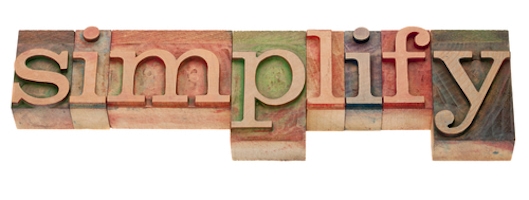 You know that feeling when you spend A-A-A-A-a-a-a-a-a-g-e-s working on something, only to get to the gig with all those good intentions of using your new found knowledge, but what happens?
You know that feeling when you spend A-A-A-A-a-a-a-a-a-g-e-s working on something, only to get to the gig with all those good intentions of using your new found knowledge, but what happens?
The chord changes are coming at you too fast. Your mind goes blank, you can’t keep up, your fingers don’t go where they should, and you slip right back into repeating the same old patterns. It feels like drowning…. lost in a sea of chords, scales, arpeggios, modes etc.
Ugh…
Here’s a method you can use to lock in knowledge so it’s at your fingertips and under your command.
Let’s say you’re looking to improve your improvising on a blues in F.
Try this little method – ‘SKIP’.
- Step 1. Simplify
- Step 2. Know It
- Step 3. Play
Here’s how it can help you:
 Step 1. Simplify
Step 1. Simplify
Instead of trying to do it all, do one thing well.
“I’m working on playing the changes, but what about all the other arpeggios, all over the neck, with superimpositions, and moving it through all keys, and, and, and….”
No! Chose ONE thing.
Ahhhhhhhnd, relax!
E.g., for F7, start here:
- Play F on the 5th string, 8th fret.
- Play A on the 4th string, 7th fret.
- Play C on the 3rd string, 5th fret.
- Play Eb on the 3rd string, 8th fret.
And that’s it for now.
In one of our premium courses – Chord Tone Improvisation – we start with a three chord blues and eventually move to more advanced harmonic things. So we’d add in Bb7 and C7 for the three chord blues and keep it simple.
Step 2. Know It [TAP]
There are three basic areas to know something like an F7 arpeggio.
The ‘Theory’ means to know the name. It’s ‘F7’, that’s a ‘dominant chord’. That means the intervals are 1 3 5 b7. Starting from F that means our notes are F A C Eb.
If you make mistakes like calling the Eb ‘D#’ – we need to be clear on WHY that’s not right. And how knowing the theory can really help you be clear on things like harmony, keys, sight-reading, and so on.
This is really the easiest bit because it’s set. It never changes. F7 will always be F A C Eb.
 So once you know it, you know it. Job done. Off to the pub :)
So once you know it, you know it. Job done. Off to the pub :)
The ‘Aural’ means to internalise the sound of F7 so that you can recognise it when you hear it, and that you can sing it. You’re building up an internal image of the sound.
The ‘Practical’ means where you chose to play that on the fretboard.
That’s the most complex part to get control over [on the guitar] because there are so many ways of playing the same thing.
So we choose to limit that to one way. Otherwise your practice becomes an unmanageable mess, and you won’t feel like you’re making any progress when you apply the next stage.
It’s the marrying up all these three complimentary areas [TAP] that sets the foundation for you to DO THINGS with this knowledge. To get straight to the PLAY – The FUN – The improvising.
Step 3. Play
 Now what we do is apply limits and games to get CONTROL over the material. And then try to move it from an exercise to music.
Now what we do is apply limits and games to get CONTROL over the material. And then try to move it from an exercise to music.
A limit gives your imagination a challenge. For example, in the first exercise in the free course, I get you to play just 1 3 5 b7, in time, over all the chords in the blues. That’s a challenge that more on the ‘exercise-y’ end of the spectrum.
To move that towards something more musical you might try an exercise like this one from the course that I call ‘The Window’ – Use the exact same 1 3 5 b7 arps you just played, but now play them with a one or two-bar rhythm. Each time you cycle through the sequence, change the rhythm.
You’re looking for ways to take that simple bit of material and extract as much as you can from it – being deliberate and precise. Working with simple material, and making applying a game/challenge/limit, puts the focus on your imagination, rather than the material. And it’s miles more fun to actually do some improvising/playing than it is to practise melodic patterns for hours.
So, those are the three steps you can use to lock in that knowledge, and start building a rock solid foundation that’ll SERVE you and your ideas.